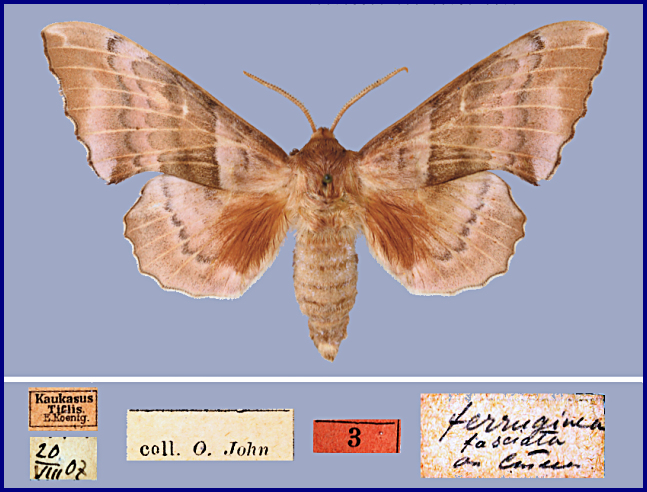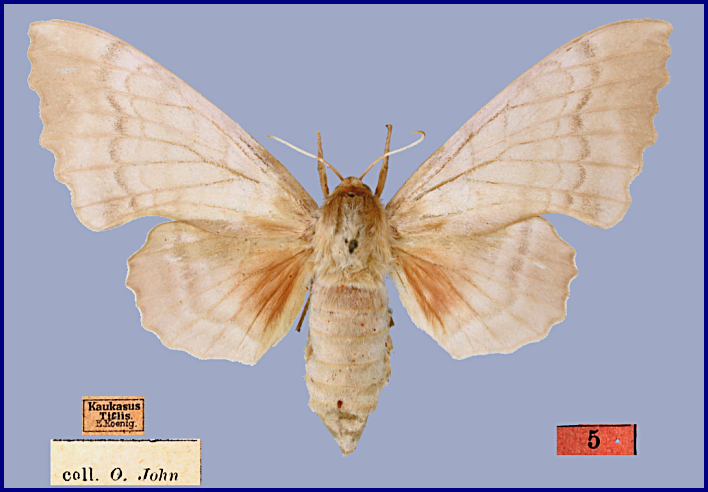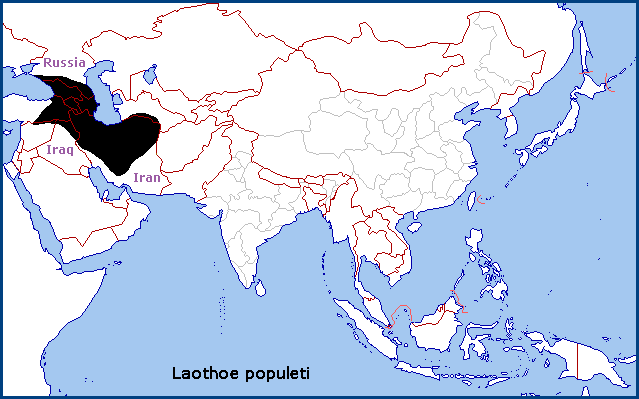UK: Persian Poplar Hawkmoth
Laothoe caucao Zolotuhin, 2018, Eversmannia (54): 8.Type locality: [Republic of Georgia], Kaukasus [Caucasus], Tiflis [Tbilisi], 20.viii.1907, leg. Koenig, coll. O. John.
(Taxonomic note. Zolotuhin (2018) separated Laothoe caucao from Laothoe populeti on the basis of a 2.4% difference in DNA barcodes (marker: COI). Given that natural variation within clearly defined taxa of the Smerinthini can vary up to 3% or more, a variation of 3.5-4% is required before a population can be considered a new species. A difference of 3% or less indicates either a new subspecies or just natural variation within a given population. As all the specimens barcoded to date are from the immediate area of Tbilisi, Republic of Georgia, there is the distinct possibility that the taxon 'caucao' represents just a local population of Laothoe populeti. It certainly does not warrant specific status, and even its subspecific status is doubtful.)
[Further details on this species, as well as photos of all stages, can be found on Lepiforum.]
Holarctic; western Palaearctic region. Pleistocene refuge: Monocentric -- Caucasus.


Wingspan: 64--74mm. Visually, indistinguishable from Laothoe populeti populeti, but smaller (Zolotuhin, 2018). Ground colour of the wings generally sandy-grey or pinkish-rose, although some may be as grey as Laothoe populi populi (Zolotuhin, 2018).
According to Zolotuhin (2018), a diagnostically important character is the shape of the forewing antemedial band, which is usually rather straight without any angle in cell R-Cu; rarely convex, and then mostly in females. Red anal spot of the hindwing shortened but touching the postmedial band. In male genitalia, apical tube of vesica with a single needle-shaped large basal cornutus, and with a small, sparse group of smaller apical cornuti; apical lobe of vesica weak.
As in Laothoe populeti populeti. From lowlands to 2600m altitude, where it inhabits mostly humid biotopes along river valleys and lakes. Not rare, and sometimes very common (Zolotuhin, 2018).
Trivoltine; mid April to mid October (Zolotuhin, 2018).)
OVUM: Pale green, almost sperical and large for the size of moth.
LARVA: Very similar to that of Laothoe populeti populeti.
Hostplants. Populus and Salix spp. Mainly on Populus nigra L. [syn. Populus pyramidalis Rozier = Populus nigra var. pyramidalis (Rozier) Spach] in the Republic of Georgia (Didmanidze, Petrov & Zolotuhin, 2013).
PUPA: Matt black or dark brown, rough (not glossy), with finer sculpturing in comparison with Laothoe populi populi, but identical with Laothoe populeti populeti. Cremaster short, dorso-ventrally flattened, broad at base and terminating in a sharp point.
None recorded.
Only reliably confirmed from the Republic of Georgia, more specifically, from the environs of the capital, Tbilisi (Zolotuhin, 2018). Also reported from the eastern Caucasus Mountains, namely Daghestan (Yakovlev et al., 2022).
However, Zolotuhin (2018) states that Laothoe populeti caucao is 'known' from the Ciscaucasus (Krasnodar, Apsheron, Khadyzhensk, Pyatigorsk, Teberd, Akhty, Essentuki, Gelendzhik, Abkhasia, and Makhachkala), and that it probably extends north to the Lower Volga Region, and may also be native to the Rostov Area and the Crimea. V. Savchuk illustrates for the Crimea [http://www.lepidoptera.crimea.ua] moths which phenotypically differ from normal Laothoe populi populi and which resemble Laothoe populeti caucao. It is also 'known' from Daralagez and Vahik in Armenia, from Nakhichevan, and Gosmalyan, Azerbaijan. He then goes on to state that phenotypically similar moths are known also from northern Iran.
In other words, individuals identifiable as Laothoe populi caucao or Laothoe populeti populeti can be found within the range of the other. A possible explanation for this is that at one time Laothoe populeti was split into two isolated populations (refugial entities) which diverged to some extent. These have since re-established contact and are merging.
Extra-limital range. None.

One, namely Laothoe populeti populeti, which occurs in southern Georgia (Borzhomi), Armenia, Azerbaijan, eastern Turkey, north-east Iraq, the mountainous Iranian plateau, and western Turkmenistan.
 Return to species list
Return to species list